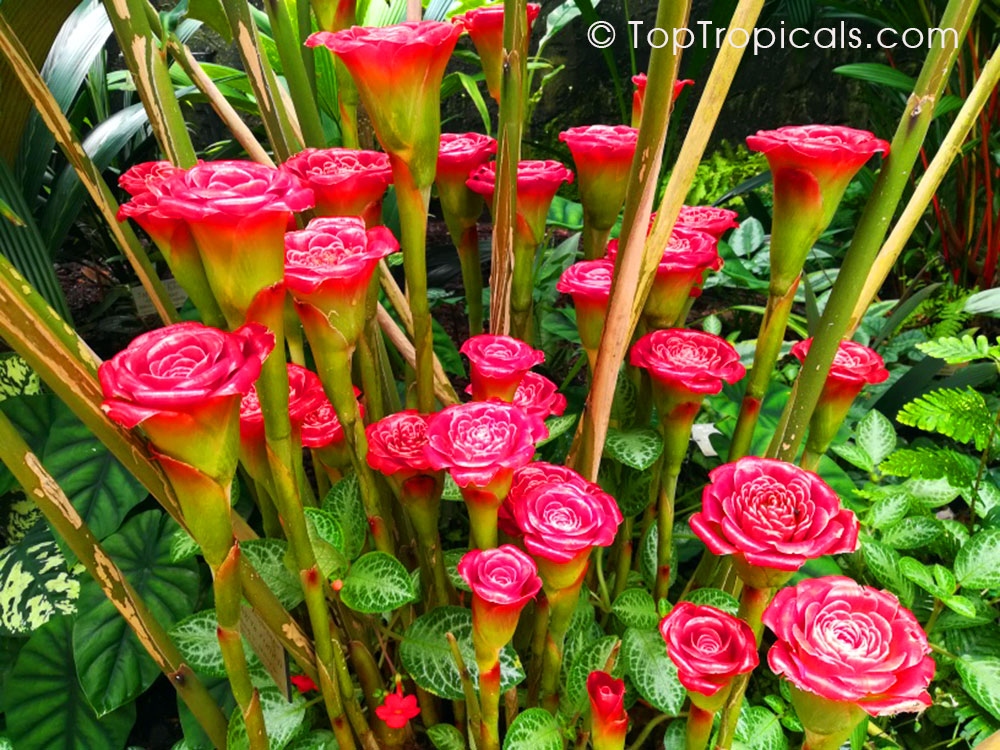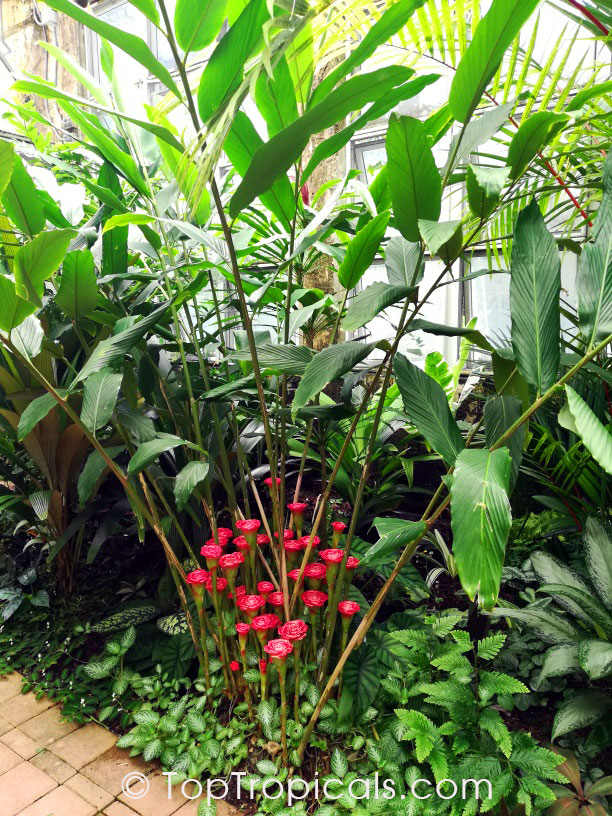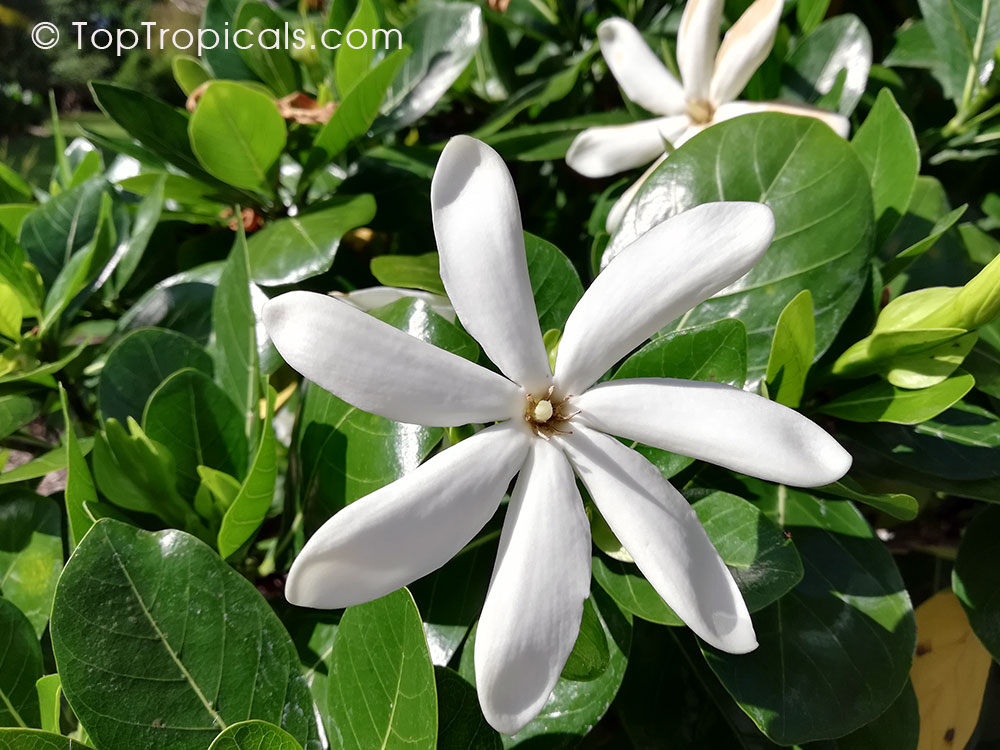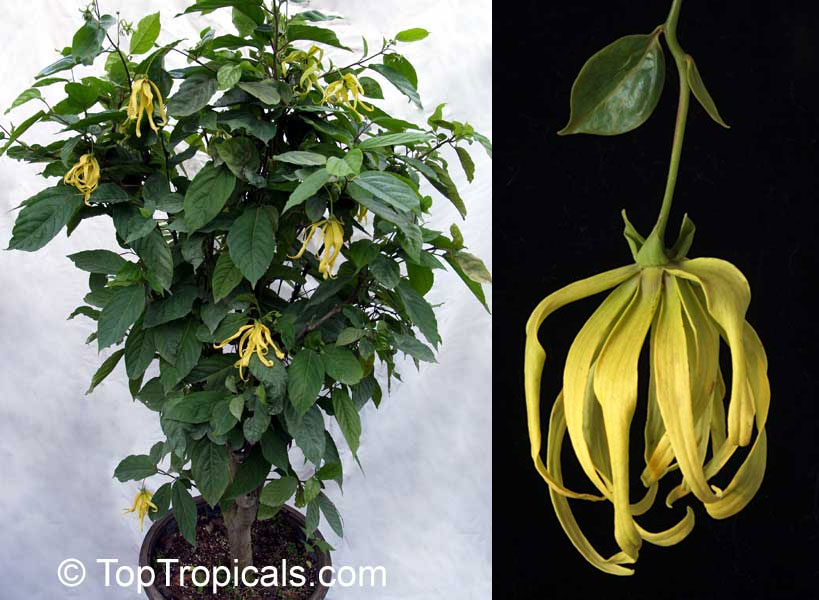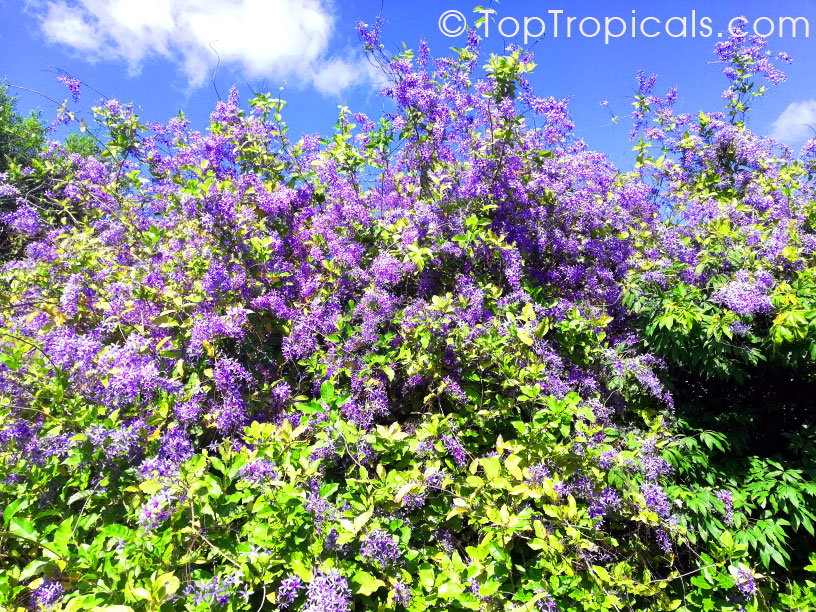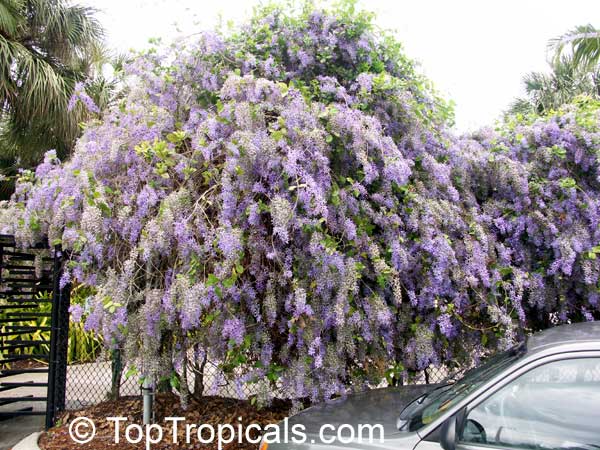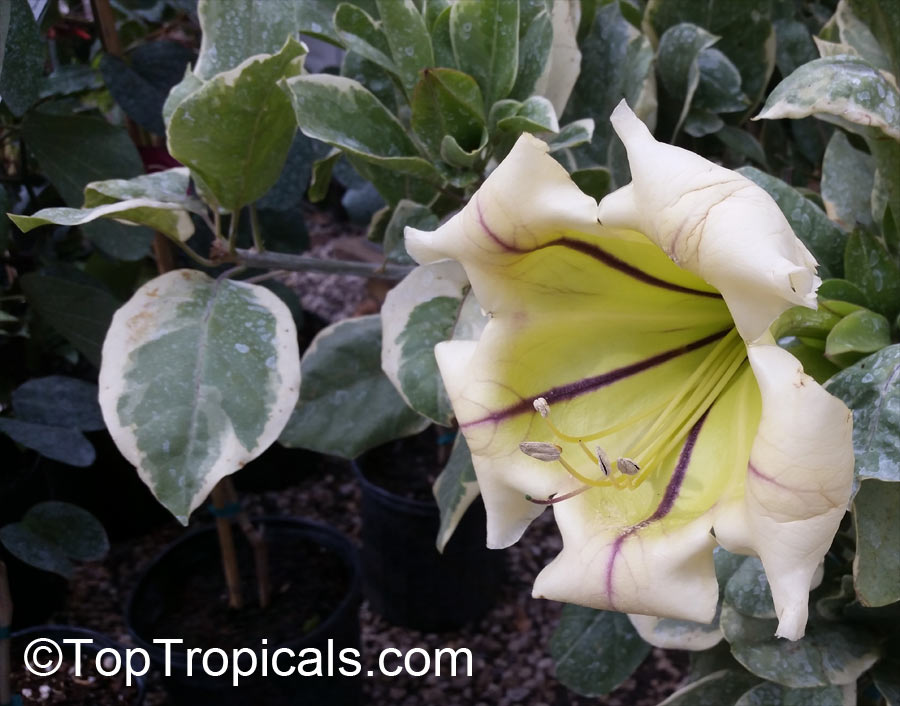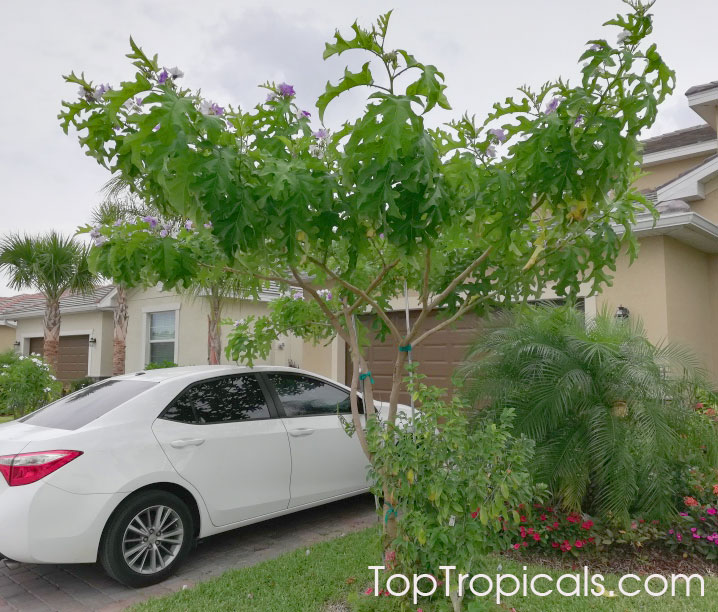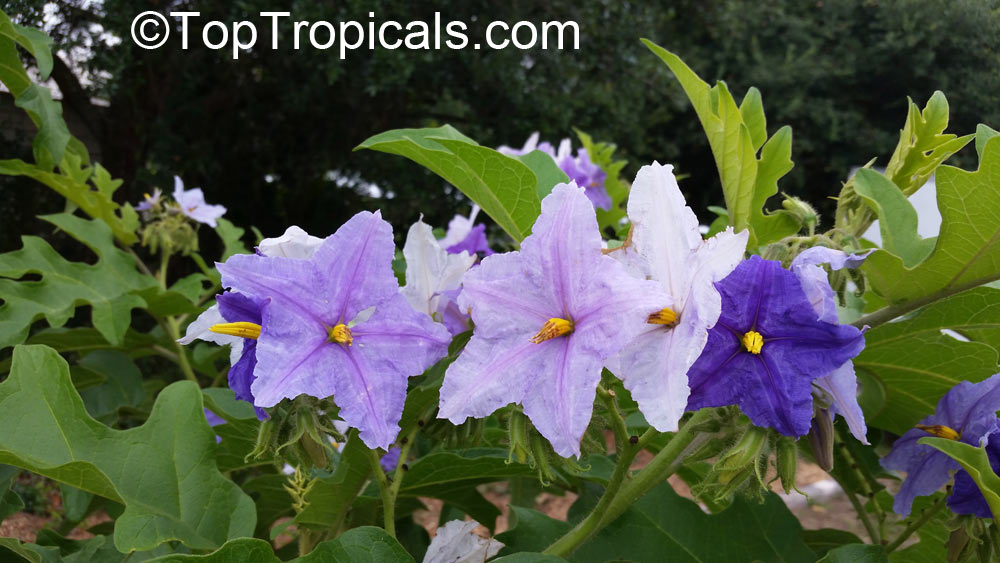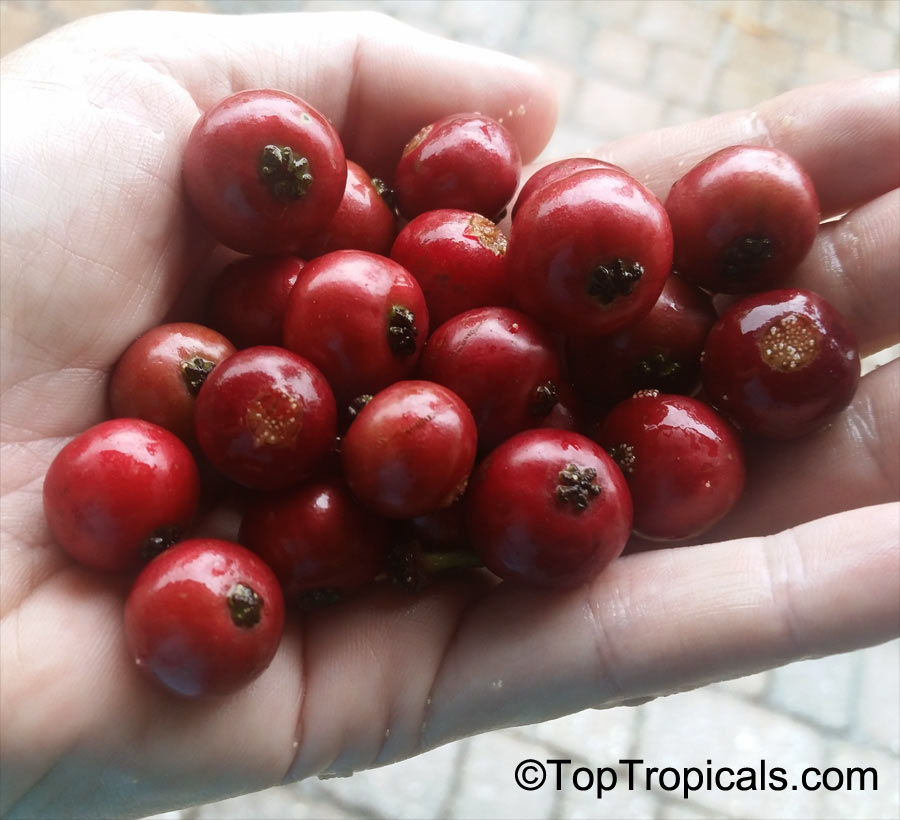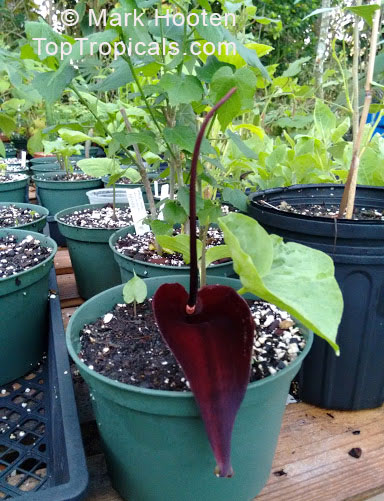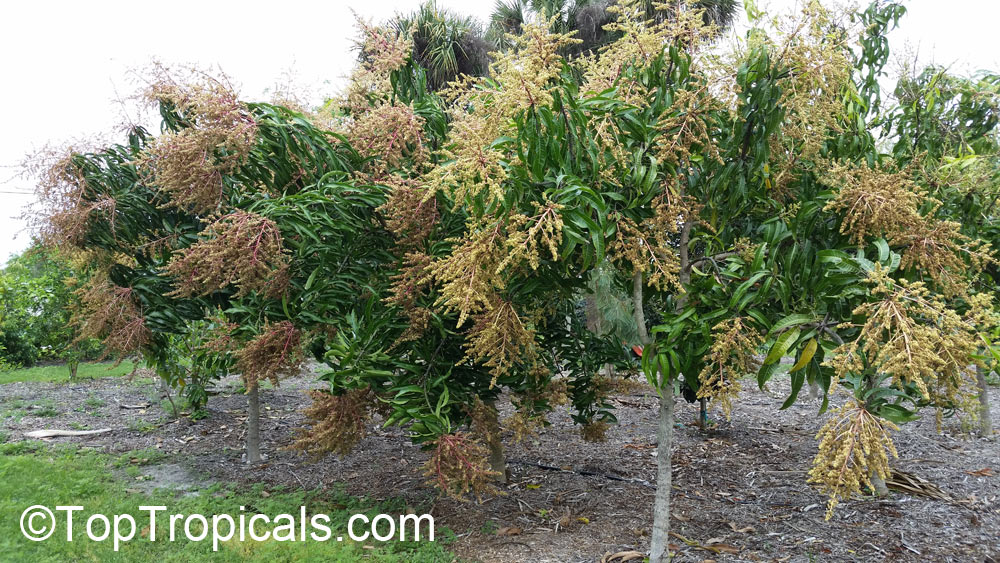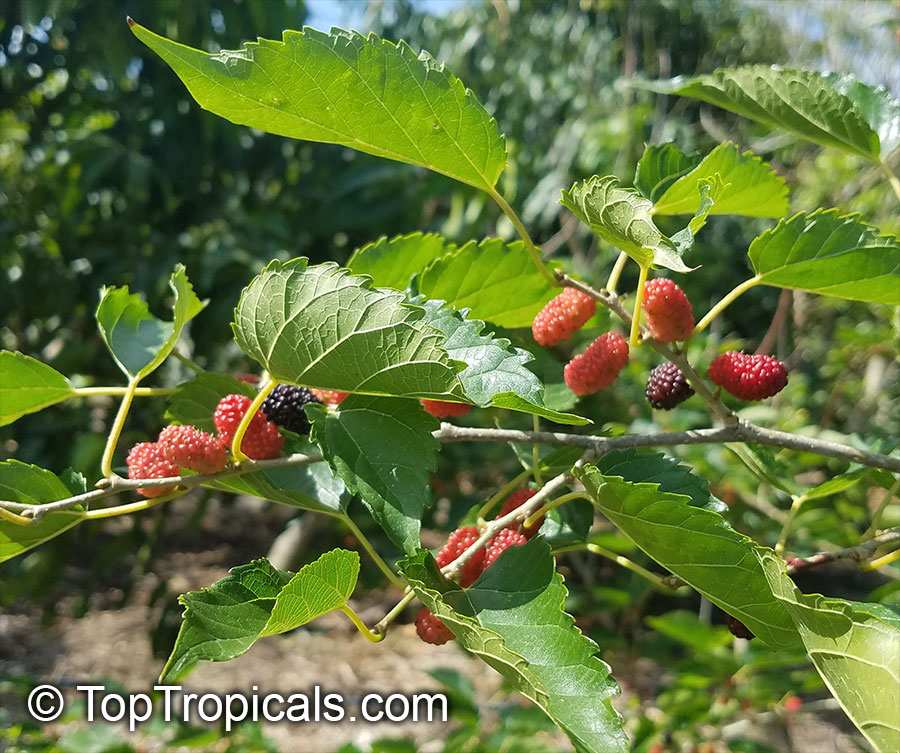Garden Blog - Top Tropicals
Date:
Persimmons - seedlings or grafted?
Q: Do all persimmons take roughly 6 years to fruit if grown from seed?
A: Persimmons, like most of the cultivated fruit trees, are recommended to be grafted to ensure a certain variety, although they may also come true to seed. And unfortunately, you are right - it will take a few years (depending on growing conditions) until the seedling will start fruiting. So your best bet to get a quality fruit right away is to obtain a grafted plant. You may check out persimmons (tropical and subtropical) that we carry in stock. If you are interested in any of the varieties that are currently sold out, just add your email to wishlist by clicking on link Notify me when available and you will be notified as soon as we have it back in stock.
Date:
Grafted Guanabana - what is the trick?
Q:Should I buy grafted Guanabana or a seedling? It is a big price difference. I have heard that Annonas fruit within 3 years from seed, why do I need a grafted tree?
A: Annona muricata - Guanabana, or Soursop - is known as the best tasting
Annona fruit. Many fruit lovers and gardeners want to have this tree in their
plant collection, and the first question they always ask is: "How soon will
it fruit? I can't wait to enjoy its deliciousness!"
Most Annonas start flowering and fruiting at a young age, 3-4 years from
seed. Annona muricata seedling takes longer. You may read more information on
how to grow Guanabanas from seed, even in a pot, even indoors - in Tropical Treasures Magazine issue # 7. Although it may take up to 15
years to see the fruit...
Now we have a solution to get this fruit sooner - a grafted tree! It
will fruit within a year after planting. The secret of grafting Guanabana was
almost lost (it's a tricky one to graft) and grafted plants were nearly
impossible to find. Now we have them! Quantities are limited.
Keep in mind that Guanabana is very cold sensitive and won't tolerate
even light freeze. However it is still relatively easy to grow even in
subtropical areas: the tree is small, and if tree grown in ground, a simple cold
protection structure can be built around it using basic wood or pipes (metal or
PVC) and covered with plastic for a few weeks of cold weather. Grafted
Guanabana is also a perfect choice for container culture (hand-pollinating maybe
required).
Photo: This grafted tree was planted less than a year ago, and was covered in winter with cold protection for about 8 weeks. Within a year, it has 4 large fruit on it!
Date:
How to get gingers to bloom
Q: I have several gingers in my yard, including Red Torch, Lobster Claw, and Red Bamboo Ginger, they grow beautifully but only produce large dark green leaves and no flowers. Is there anything I can do to make them bloom? Do they need any special fertilizer?
A: Gingers are easy to grow tropical plants with so many benefits, giving us unique spice, and showy flowers (including long-lasting cut flowers!) - where other plants fail, especially in deep shade. They are not fussy about soils and even water once established. To keep your gingers happy, follow these simple steps:
1. Bright light is essential for flowering, but planting gingers in
semi-shade or filtered light will keep them stress-free from burning summer rays.
2. Water gingers regularly until they established and start producing
new leaves and stems. Once they start clumping, you may reduce watering to a
minimum 9once a week or so), or rely on your sprinkler system.
3. Once the plant is established, start using fertilizer to induce
flowering and healthy growth.
- We recommend granulated "smart release" fertilizer for all tropical
plants. For gingers, the best formula is Tropical Allure. It provides all macro- and microelements essential for
the healthy growth of the plant.
- Apply balanced water-soluble plant food for Gingers, Heliconias and
Bananas -
Broad Leaf Plus - once a month.
- Additionally, you may also add to the menu flower booster Pink N Good Daly Plant Food - this fertilizer is used in very low
concentration and can be used with every watering.
4. Remove old dry and yellowing leaves with sharp cutters to avoid pest
problems and keep good air circulation around these clumping plants.
5. Keep soil covered with 1" mulch to protect from weeds and maintain
the optimal amount of moisture for the rhizomes.
Check out our specialized fertilizers for different plants - for all your gardening needs!
Date:
How to make the whole garden fragrant.
List of the most fragrant yet easy to grow plants
Q: Dear toptropicals, thanks for the great database on tropicals plants! I really enjoy browsing your web site and I am planning on completing my collection by purchasing some plants from your shop. I am particularly looking for fragrant plants that make the whole area fragrant. Can you provide a list of recommended fragrant plants that bloom throughout the year round? I currently have: murraya, plumeria, michelia alba, figo, champaca, rangoon creeper, honeysuckle, jasmine, stephanotis, Arabian sambac, brunfelsias.
A: As a must-have additions to your impressive fragrant plant
collection, we can recommend the following rare fragrant plants below. These are
our favorites that are easy to grow and free-flowering. Since they flower at
different times, they will add fragrance to your garden throughout the year.
Aglaia odorata - Chinese Perfume Plant
Aloysia virgata - Almond Bush
Beaumontia grandiflora - Easter Lily Vine
Brugmansia Variegated Orange Angel Trumpet
Brunfelsia magnifica floribunda Jims Giant (very fragrant and very
compact!)
Cananga fruticosa - Dwarf Ylang-Ylang
Cerbera x manghas hybrid - Enchanted Incense
Cestrum nocturnum - Night blooming jasmine
Crinum Queen Emma - Spider lily
Eucharis grandiflora - Amazon Lily
Euodia hortensis - Scented Evodia, Golden False Aralia (very fragrant
leaves!)
Hedychium coronarium - Butterfly Ginger
Hiptage benghalensis - Helicopter Flower
Jasminum dichotomum - Rose Bud Jasmine - very fragrant!
Magnolia virginiana - Sweet Bay
Millettia reticulata - Evergreen Wisteria
Mirabilis jalapa - Four oclock plant - super fragrant!
Osmanthus x fortunei - Fortunes Tea Olive
Oxyceros horridus- one of the most intense perfume fragrances!
Radermachera Kunming - Dwarf Tree Jasmine
Satureja Viminea - Kama Sutra Mint Tree - strong mint fragrance
Sclerochiton harveyanus - Blue Lips, Mazabuka - lavender fragrance
Solandra maxima - Variegated Butter Cup
Telosoma cordata - Pakalana vine
Wrightia religiosa - Sacred Buddhist
You may consider many varieties of gardenias, and the most rewarding
are:
Gardenia vietnamensis - Vietnamese Gardenia
Gardenia Aimee Yoshioka (First Love)
Gardenia posoqueria - Shooting Star Gardenia
Gardenia taitensis Heaven Scent (double flower)
Gardenia taitensis Tiare Tahiti, single flower
Gardenia tubifera Kula - Golden Gardenia
To see the full list of fragrant flowers, follow this link.
Date:
The Mother of All Bamboo - Bambusoid Grass
By Mark Hooten, the Garden Doc
 The missing genetic link is found! The tiny little "bambusoid grass" is actually the original ancient ancestor of Bamboo
and all members of the Bambusoideae, the giant woody grasses!
This plant is the evolutionary mother of ALL modern bamboo's that that has
just never really been made available to the general public...
The missing genetic link is found! The tiny little "bambusoid grass" is actually the original ancient ancestor of Bamboo
and all members of the Bambusoideae, the giant woody grasses!
This plant is the evolutionary mother of ALL modern bamboo's that that has
just never really been made available to the general public...
...So I decided to begin propagating my own Lithachne humilis colony.
After a few months of hovering over delicate seedlings, I have a few to offer!
But there is a story behind it... Continue reading...
Date:
The most desired iconic Chanel flower...
By Onika Amell, tropical flower specialist
Q: I live in Beverly Hills, Los Angeles. I'm looking for something fragrant to grow on my porch. I don't have a lot of space and am interested to find something unusual that won't grow too large. Any suggestions? I've heard about Chanel #5 tree and I wonder I can keep it in a pot?
A: The Ylang-Ylang tree, Cananga odorata, emits a fragrance so soft and beautiful it became an essential ingredient of Coco Chanel's iconic and much-loved perfume Chanel No 5. Trouble is, it will grow into a giant. How do you get this kind of magic onto your lanai or porch? Opt for its smaller relative: Dwarf Ylang Ylang, Cananga fruticosa (pronounced ee-lang ee-lang, meaning: flowers of flowers).
The fragrance is a little less intense than its larger cousin, but still wonderful to have around.
Let the fragrance drift slowly through the air into your home at night. The scent is strongest from dusk to dawn and it will
need warm and humid conditions for a fuller aroma.
Dwarf Ylang-Ylang is ideal for folks with limited space as it can be
grown in a container or as a house plant. It's a very unusual and interesting plant to add to your porch, lanai or garden. It's
pretty easy to grow and disease resistant too. It will stay compact and in nice tree-like shape. Dwarf Ylang Ylang starts
blooming quite young and will continue to bloom year-round with profuse blooming during the spring and summer months.
The tree prefers a high-humidity environment, evenly moist soil, warm temperatures and will grow best in plant hardiness zones 10-11
but can take short periods of cold.
Read
more about Chanel No5 Flower...
Dwarf Ylang Ylang is certainly one of the most desired and sought after rare, fragrant plants. Get yours today!
Date:
Growing Noni tree for fruit
Q: I would like to buy a noni tree, something that would produce much fruit as soon as possible. I live in NJ, would you ship here?
A: Noni is one of the most suitable fruit trees for potting culture. A 1-3 gallon size plant will flower and fruit for you within a year. These are Noni's special features:
- flowers and fruits at young age, nearly year around
- tolerates shade and grows large ornamental leaves in filtered light
- suitable for indoor culture
- easy in cultivation, drought and water tolerant, not susceptible to insects
- medicinal properties are endless and cannot be under-appreciated
This plant can be shipped to any state, and will produce fruit for you under minimal care. Just provide warm frost-free conditions, as this tropical tree is very cold sensitive.
Date:
Breathtaking Queen's Wreath
By Onika Amell, tropical flower specialist
Q: I've just moved from Virginia to Sarasota, Florida. I'm looking for a vine similar to Wisteria to grow in my new garden. I've so enjoyed my Wisteria vine and I'm hoping to find something equally spectacular for my FL garden. Truth is, I'm getting older and won't be able to keep up with the hard-core maintenance Wisteria needs to keep it in under control. Is there a similar vine you can recommend that is just as showstopping as Wisteria?
A: The vine that immediately comes to mind is Petrea Volubilis or Queens wreath. It looks similar to Wisteria, and though a fast and strong climber, it's not invasive or
destructive at all. An occasional pruning is all it will need to maintain it.
Much like Wisteria it gives a glorious show of flowers when spring arrives.
Masses of long, mauve flowers will continue to appear on and off in summer with
another burst of flowers in the fall. Flowers are up to a foot in length!
Hummingbirds, bees, and butterflies will all be impressed with you for
growing this charmer.
Snip off the gorgeous flowers, put them in shallow bowls of water
around your home and be the envy of all your friends and house guests!
This vine prefers the warmth of Zone 10 to thrive, but it will survive
in areas of Zone 9B when it borders zone 10A, especially if it's placed in a
protected area. It grows best in full sun but will tolerate part shade. It's
great for coastal gardens and once established, it has good drought
tolerance, medium salt tolerance, and good wind tolerance. It has no major pest
problems, which is always a bonus.
Grow and shape it as you like: a large bush, a small tree or a
breathtaking espalier. Some people plant Petrea vine by a tree to create that much
sought-after ethereal wisteria effect. This is no doubt a very charming vine
and a must-have for those who are in love with Wisteria but scared of its
vigorous growth and ongoing maintenance.
For Wisteria lovers we also recommend its spectacular tropical relative
Millettia reticulata - Evergreen Wisteria.
Date:
How to propagate plants from cuttings. Top (Tropicals) secrets.
Q: After pruning my jasmine, I have so many branches and I don't have a heart to through them away, can I use them to make more plants? Please tell me what size cuttings and do I need to remove leaves? Should I just stick them in the ground? Will they root? I don't know if you will be willing to share your secrets?
A: We are always happy to know that you grow more plants, and make our World better! These are some useful tips for the propagation of tropical plants using cuttings:
- Cuttings and leaves. Use cuttings 2-5" long. Strip leaves from
the bottom. Cut larger leaves in half to reduce evaporation.
- Soak cuttings for 15-30 min in SUNSHINE solution.
- Mix. Use special well-drained mix with lots of soil conditioner: we
have a special professional propagation mix for cuttings.
- Mist. Put community pots or trays with cuttings in mist, or if you
don't have mist - cover the pot with a clear plastic bag to create a
mini-greenhouse.
- Shade. Keep propagation pots in bright shade and never allow direct
sun rays.
- Rooting hormone: yes, use it if you have it. Not only it promotes
root formation but also prevents from fungus so the cuttings won't rot. We use
Dip-N-Grow.
- Rooting and food. Check in 2-3 weeks for roots. Once you see the
little roots, begin fertilizing with a special Baby-Plant Food and make sure never exceed recommended doze otherwise
you may kill the cuttings.
- Establishing. Once roots start growing, plant in 4" pots in a well-drained potting mix and watch the beauty grow! Gradually move to
the full sun only when little plants establish and start new growth.
If you are lucky to make more rare plants than you can use, contact us, we will buy them from you or trade for your dream plants! In fact, one of our customers from many years ago started selling us baby plants that he propagated from our plants, and now has a successful business (Karma Nursery); we buy a lot of plants from him every month!
For more ideas on tropical plant propagation, see also:
- Secrets of turtle tank propagation
- 5 secrets of propagation
Date:
Impossibly exotic Chalice Vine
By Onika Amell, our flower specialist
Q: I live on Sanibel Island, Florida and I'm looking for an exotic vine to cover the side of my house. A friend suggested Chalice vine. What can you tell me about it and will it tolerate the salty soil and salt spray of the island?
A: Chalice vine, or Cup of Gold - Solandra maxima - is a large,
woody, scrambling tropical vine with huge, cup-shaped flowers. Variety
Variegata has also amazing cream and green variegated foliage. The flowers are
fragrant, especially in the evenings, with a lovely coconut-like aroma. This
unusual vine will give you intermittent waves of large, wide flaring golden
trumpets.
Even when not in flower, it is beautiful as new growth is bright and
purple-bronze in color. It has a large and loose spreading habit. As this vine
ages, flowers will appear along the entire length of branches off the main
vine. So, just think about it - up to 100 feet vine and you will have about 500
flowers at the same time! They are very fast growing and usually bloom from
February until May. Plant them... Sit back and wait... Four months of heaven!
They are great for seaside gardens as they are very tolerant of salt
spray and salty soils. Will, in fact, thrive in most any well-drained soil.
Give it a large, sturdy pergola or trellis, or train it to grow up the
side of a house where it will spill down over windows and doorways to take
your breath away... Chalice vine is impossibly exotic!
Date:
Quick shade for your driveway
Q: Please help! We just moved into a new house in Florida and don't have any mature trees yet, but the sun is already brutal! Can you suggest any super-fast growing shade tree that can make shade over my driveway as soon as possible?
A: Check out Giant Potato Tree - it is very fast growing, has very large leaves plus very pretty purple flowers as a bonus year round! The pictured tree was planted from 3 gal only 6 months ago, and already covers with shade the whole car. It is small to a medium size tree, but one of the fastest growing. If you are looking for a larger tree and willing to be more patient, here is the full list of tropical and subtropical fast growing shade trees. Most of them may take a few years until they reach a mature size, however, in order to enjoy your shade tomorrow, you must plant the tree today!
Date:
Fruit tree size and production
Q: I am interested in a Strawberry Tree... does this tree produce fruit while still small or do I have to wait until it is large before it produces? Should I fertilize it so it produces sooner? I ask because my garden is not large and I prefer to keep my fruit growing trees in a smaller size. Also, how big is the fruit and does it have a seed?
A: Strawberry Tree, Muntingia Calabura, is one of those fascinating fruit trees that starts
flowering and fruiting in small size. We have plants growing in 1 gal
containers that already have flowers. This tree is nearly year-round producer
providing warm conditions. It is a fast grower, although a compact tree when
mature, and can be trimmed to desirable size without affecting production.
Muntingia fruit is one of our favorites. It is super sweet and juicy,
and the seeds are tiny small, not bigger than the strawberry seeds, so you
don't have to spit them out. The fruit size normally about 1/2 inch, but we have
a tree in our garden that produces almost cherry-size fruit! See picture
above. The secret is, good watering and using fruit booster - SUNSHINE honey micro-element supplement. We also fertilize our fruit
trees using Fruit Festival and Mango-Food fertilizers.
Date:
Love (and FEAR) the black flowered Dead Rat Lily!
By Mark Hooten, the Garden Doc
I acquired this rare and freaky aroid, (Typhonium roxburghii) when my wife Suzie and I were living in So. California in the early 1990's... When I first saw this plant (growing in a few pots of bamboo, along with other weeds), it had perhaps the most unusual flowers of anything I had ever seen...Date:
Growing mango tree in California
Q: I just ordered a mango tree. I live in Southern California and was wondering if you have any tips on how to acclimate the mango to our climate. I know it is coming from hot and humid Florida to hot and dry Southern California and don't want to kill it because of the differences in climate.
A: Mangos in fact prefer dry conditions rather then humid. It may
be perfect conditions for a mango tree at your place. Plant your tree in a
pot size of the root ball; give it ample water and then let the soil surface
slightly dry before watering again. Keep the plant in bright shade and
gradually move into full sun. Once the tree is recovered from shipping stress, you
may plant it in the ground and make sure to protect from freezing temperatures
in winter. Use Mango Food for quick establishing and better fruit production. More to
read:
Mango boosters
How to grow Mango in hot climates
Growing Mango in Arizona.
Date:
More about Mulberries
Customer comment on our Mulberry column in the previous newsletter:
...I planted a Himalayan mulberry, Morus macroura, about six years ago.
For several maddening years, it shot only very long, un-branching tentacles
out there, and it resisted my efforts to force some branching by pruning. It
would send another long, reaching shoot from the tip of the pruned branch,
with NO laterals. Several times, it did this. Finally, two years ago, it broke
buds that looked like they meant it all along those long branches, and in one
season, it fluffed out. The next season it elaborated on this, acting much
more like a proper tree. The fruit is fabulous, three or more inches long, very
sweet, with a rich berry flavor that's more raspberry than mulberry. I
guess it just needed more time. My understanding is that mulberries don't
really like to be pruned, but it needed to happen in this case, along a driveway,
so I reigned it in, and now it's a treasure. Be patient.
Cheers, your admirer, C
Check out our Mulberry trees.



